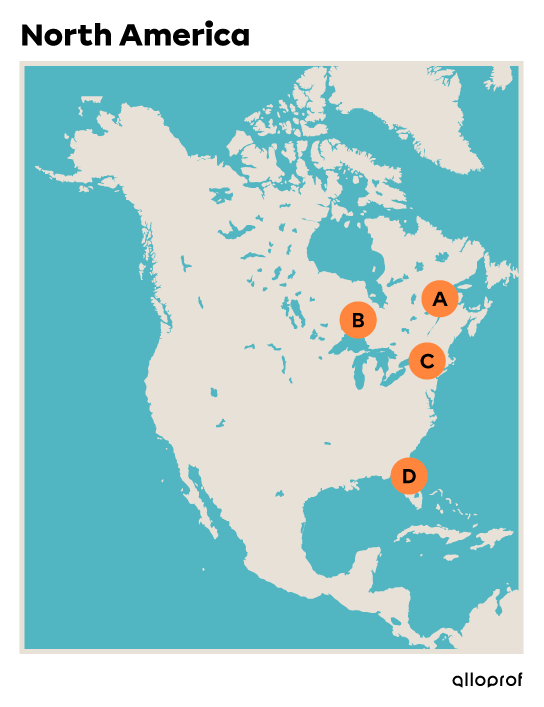There may be more than one correct answer in some of the examples or exercises on this page. All correct answers are not necessarily listed.
“Situate in space” means knowing how to read and interpret geographical landmarks and being able to identify a place or a territory on a map, whether geographical, political, thematic, etc.
Time and space are often linked. The task might involve identifying a territory at a specific time based on chronological markers (timespans).
A question that asks you to identify the borders of Canada in 1867 will have a different answer than a question that asks you to identify them in 2000.
The tasks in this intellectual operation require you to identify a feature on a map. You may have to locate a territory, such as Canada, or pinpoint the location of an event, such as the region where the main battles took place during the Patriote uprising. As mentioned, it is often important to consider timespans.
From the following places, identify the place where meals are usually prepared by indicating the letter that matches the correct answer.

The kitchen is where meals are prepared. The correct answer is B.
It is highly recommended that you read the concept sheet on intellectual operations to fully understand how to complete the tasks for the different intellectual operations.
The two examples below are similar to those you might encounter on an exam. Try to complete the task before looking at the detailed solution. This will help you to see how well you can do the intellectual operations.
The two examples below are related to concepts that you might not have seen before. If so, don’t worry, you’ll learn about them when they are introduced in class.
The Cycle One example is from the module The Emergence of a Civilization.
The Cycle Two example is from the module The Development of Colonial Society Under the Authority of the French Metropolis (1608-1760)
Statement:
Using the document, identify the letter that matches the territory occupied by the Mesopotamian civilization.
Document 1

Statement: Using the document, identify the letter that matches the territory occupied by the Mesopotamian civilization.
What do you need to do? Identify.
What do you need to identify? The Mesopotamian region.
What do you need to use? The map and the letters identifying the regions.
Document 1

|
Who? |
|---|
|
- |
|
The document and statement do not identify the who? component. |
|
What? |
|
The Mediterranean territory |
|
This information can be found in the title of the map. |
|
When? |
|
2500 BC |
|
This information can be found in the title of the map. |
|
Where? |
|
Around the Mediterranean |
|
The Mediterranean Sea is in the middle of the map, surrounded by different territories. |
|
Why? |
|
- |
|
The document and statement do not identify the why? component. |
This is a map that shows the territory around the Mediterranean Sea around 2500 BCE.
For this document, the place (the Mediterranean Sea) is part of the subject of the document. The historical phrase is adapted accordingly.
You know Mesopotamia was located in a region called the Fertile Crescent.
You know the Mesopotamian region was located between two rivers.
You know the territory at the bottom right of the map shows the Nile River, which is the territory of Egypt.
The correct letter to indicate is C, because it identifies the region occupied by the Mesopotamian civilization. You can identify it by the fact that it is located between two rivers.
Statement: Using the document, identify the letter that matches the region most French settlers occupied in the 17th century.
Document 1

Statement: Using the document, identify the letter that matches the region most French settlers occupied in the 17th century.
What do you need to do? Identify.
What do you need to identify? Locate the area most French settlers occupied in the 1600s.
What do you need to use? Use the map and the letters attributed to the regions.
Document 1

|
Who? |
|---|
|
- |
|
The document and statement do not identify the who? component. |
|
What? |
|
North American territory |
|
This information can be found in the title of the map. |
|
When? |
|
- |
|
The document does not identify the when? component. |
|
Where? |
|
In North America |
|
This information can be found in the title of the map. |
|
Why? |
|
- |
|
The document and statement do not identify the why? component. |
This is a map that shows the territory of North America.
For this document, the place (North America) is part of the subject of the document. The historical phrase is adapted accordingly.
You know the colonists arrived by boat.
You know the St. Lawrence River was a very important waterway for them. You know the St. Lawrence Valley was a very important place early on for the colony in the 17th century.
You know the land in the St. Lawrence Valley was fertile and that cities were built there.
The correct letter to indicate is A, because it identifies the region most French settlers occupied in the 17th century.